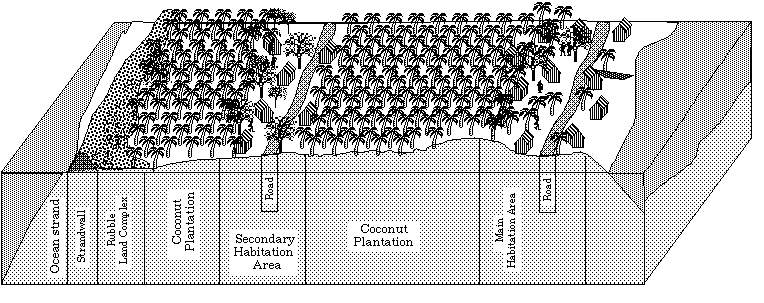|
AGROFORESTRY
An area with cultivated trees (and some wild plants) often forms an artificial forest with understories of shrubs and herbs, which scientists refer to as an "agroforest." This type of man-made forest, or traditional agroecosystem, combines native and alien species. Agroforestry has been defined technically as "any sustainable land-use system that maintains or increases total yields by combining food (annual) crops with tree (perennial) crops and/or livestock on the same unit of land, either alternately or at the same time, using management practices that suit the social and cultural characteristics of the local people and the economic and ecological conditions of the area."

Typical modern vegetation zonation pattern of a leeward atoll island (Illustration by Spennemann).
Agroforestry is the major agricultural land use in the Marshall Islands today, as it has been for centuries. Nearly all production of crops is done by family units using local agroforestry technology. Commercial monocropping (cultivating a single crop) in copra (coconut) plantations was developed in historic times. Under the Japanese administration (1914-1915), the Marshall Islands produced the most copra in Micronesia. Today many groves are aging and not well maintained. Copra production has been steadily declining in recent decades.
Traditional agroforestry in the Marshall Islands is a complex, sustainable system of land use. It does not generally exhaust the soils, and thus continues to provide much food and other resources such as timber, fiber, and medicine for the people in areas where it is still practiced. Nevertheless, although the traditional cropping system of agroforestry has significant value in its provision of nutrition, cultural preservation, and rural economic stability, this long-lasting local farming system is changing. For example, there is evidence that use of taro pits (bōl) to cultivate plants such as iaraj (giant taro) is declining in some islands due to the importation of foreign foods such as rice and flour.
Before we discuss the problems associated with the current changes in and decline of traditional agroforestry, and the relationships of this decline to human population growth and commercial development, let us briefly review the historical development of agroforestry in the Marshall Islands and some key cultural factors involved.
When Micronesian settlers first arrived in the Marshall Islands from their ancestral homeland beginning perhaps more than 3,000-4,000 years ago, they found low-lying atolls and reef islands covered with native vegetation of strand, scrub, forest and, on some islands, mangroves. Plants brought in by these early settlers, especially breadfruit, coconut, taro, and pandanus, probably became major components in the agricultural system soon after their arrival. At the same time, early settlers in the Marshall Islands also learned to make use of the native plant species of their newfound home. Over a long period of time, numerous crop plants and agricultural techniques were introduced through continued waves of human migration and cultural exchange. Agroforestry in the Marshall Islands is the result of thousands of years of development and refinement.
In addition to the trees, shrubs, and herbs that are planted in the cultivated areas, there are also many woody and non-woody plants that grow wild (in other words, without human help) in cultivated areas. Some are cut down, while others are not removed from the cultivated areas because they are useful, providing a variety of resource materials. Several plants, usually non-native species, are commonly found in disturbed areas such as ditches, rubbish piles, and roadsides. The vegetation in these disturbed areas is called "ruderal." It contains mostly "weedy" plants that are common throughout the tropical Pacific region. Weedy plants may be defined as plants found in areas where they are not wanted.
Although no record remains of the original Marshall Islands vegetation, we know that people have been in this region for thousands of years. These people, the ancestors of the present Marshallese, unquestionably altered the biota (plants and animals) and changed some environmental conditions; but they reached a balance or ecological equilibrium with their low coral island environments, and most of the original species and vegetation types probably survived. As we noted, change has been much more dramatic in modern times, including the period during which German, Japanese, and American colonial governments were in control. On this Website, we examine the ethnobotany (traditional knowledge and use of plants in a particular society) of the Marshall Islands and survey the variety of traditional and modern uses of plants in the Marshall Islands.
Vegetation Zones
Main Plants
|

